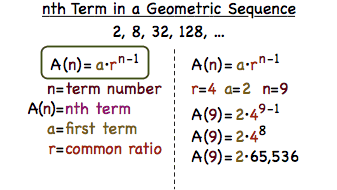Imagine yourself exploring a vast mathematical landscape, where each step leads you closer to unraveling the hidden patterns of numbers.
In this journey, geometric sequences stand tall as a mountain range, captivating with their elegant structure and precise progression.
But fear not, for within this paragraph lies the key to deciphering their secrets.
Brace yourself as we uncover the simple yet powerful method to unearth the elusive nth term of geometric sequences.
What Are Geometric Sequences?
Geometric sequences are a type of numerical sequence that follow a specific pattern involving a common ratio between consecutive terms. These sequences are characterized by the fact that each term is obtained by multiplying the previous term by the same constant factor. This constant factor is known as the common ratio. For example, in the sequence 2, 4, 8, 16, the common ratio is 2, because each term is obtained by multiplying the previous term by 2.
One important property of geometric sequences is that they can either increase or decrease exponentially. If the common ratio is greater than 1, the sequence will increase exponentially, while if the common ratio is between 0 and 1, the sequence will decrease exponentially. This property makes geometric sequences particularly useful in various fields such as finance, physics, and biology, where exponential growth or decay is often observed.
Another key characteristic of geometric sequences is that they can be defined using a recursive formula or an explicit formula. The recursive formula allows you to find any term in the sequence by using the previous term, while the explicit formula allows you to find the value of any term directly, without having to go through the previous terms.
Understanding what geometric sequences are and how they work is essential when it comes to solving problems involving growth or decay. By recognizing the common ratio and applying the appropriate formulas, you can easily find any term in the sequence and make accurate predictions.
Understanding the Common Ratio
To fully grasp the concept of geometric sequences, it’s important to understand the role of the common ratio in determining the pattern of the sequence. The common ratio is a key factor that governs how each term of the sequence relates to the previous one. It’s essentially the constant multiplier that’s applied to each term to obtain the next term in the sequence.
In a geometric sequence, each term is found by multiplying the previous term by the common ratio. For example, if the first term is 2 and the common ratio is 3, the sequence would look like this: 2, 6, 18, 54, and so on. Each term is three times greater than the previous term because the common ratio is 3.
Understanding the common ratio allows you to predict and find any term in a geometric sequence. By knowing the first term and the common ratio, you can use the formula for the nth term of a geometric sequence to find any term in the sequence. This formula is given by Tn = a * r^(n-1), where Tn represents the nth term, a is the first term, r is the common ratio, and n is the position of the term in the sequence.
Steps to Finding the Nth Term
To find the nth term in a geometric sequence, follow these steps.
First, identify the first term of the sequence, which is usually denoted by ‘a’. This is the starting point of the sequence.
Next, determine the common ratio, represented by ‘r’. The common ratio is found by dividing any term in the sequence by its preceding term.
Once you have ‘a’ and ‘r’, you can use the formula for the nth term in a geometric sequence. The formula is given by: an = a * r^(n-1), where ‘an’ represents the nth term and ‘n’ is the position of the term in the sequence.
Now, plug in the values of ‘a’, ‘r’, and ‘n’ into the formula and solve for ‘an’. Remember to subtract 1 from ‘n’ before raising ‘r’ to the power of ‘n-1’.
Finally, simplify the expression to get the nth term of the geometric sequence.
Examples of Finding the Nth Term
Here are some examples that demonstrate how to find the nth term in a geometric sequence.
Let’s start with an example where the first term (a) is 2 and the common ratio (r) is 3. To find the nth term, you can use the formula:
nth term = a * (r^(n-1)).
If we want to find the 5th term, we substitute n with 5, a with 2, and r with 3 in the formula. The calculation would be:
5th term = 2 * (3^(5-1)) = 2 * (3^4) = 2 * 81 = 162.
Now, let’s consider another example. Suppose the first term (a) is 4 and the common ratio (r) is 0.5. To find the nth term, we use the same formula:
nth term = a * (r^(n-1)).
Let’s find the 7th term. Substituting n with 7, a with 4, and r with 0.5, we get:
7th term = 4 * (0.5^(7-1)) = 4 * (0.5^6) = 4 * 0.015625 = 0.0625.
Tips for Solving Geometric Sequence Problems
Now let’s explore some useful strategies for solving problems involving geometric sequences. When faced with a problem involving geometric sequences, it’s important to first identify the common ratio, which is the constant value by which each term is multiplied to obtain the next term. Once you have determined the common ratio, you can use it to find the nth term of the sequence.
One helpful tip is to use the formula for the nth term of a geometric sequence, which is given by the formula:
an = a1 * r^(n-1).
Here, an represents the nth term, a1 is the first term of the sequence, r is the common ratio, and n is the position of the term you want to find.
Another strategy is to use the explicit formula for the sum of a geometric sequence, which is given by the formula:
Sn = a1 * (1 – r^n) / (1 – r).
This formula allows you to find the sum of the first n terms of a geometric sequence.
Additionally, if you’re given the sum of a geometric sequence and the common ratio, you can use the formula for the sum of an infinite geometric series, which is given by the formula:
S = a1 / (1 – r).
This formula allows you to find the sum of an infinite geometric sequence.
Frequently Asked Questions
How Can Geometric Sequences Be Applied in Real-Life Situations?
In real-life situations, geometric sequences can be used to model exponential growth or decay. For example, population growth, compound interest, and the spread of diseases can all be understood using the principles of geometric sequences.
Is It Possible for a Geometric Sequence to Have a Negative Common Ratio?
Yes, it is possible for a geometric sequence to have a negative common ratio. In such cases, each term of the sequence will have a negative sign, resulting in a decreasing pattern.
Are There Any Shortcuts or Formulas to Find the Sum of a Geometric Sequence?
Yes, there is a formula to find the sum of a geometric sequence. It involves multiplying the first term by (1 minus the common ratio to the power of n), then dividing by (1 minus the common ratio).
Can the Nth Term of a Geometric Sequence Be a Decimal or a Fraction?
Yes, the nth term of a geometric sequence can be a decimal or a fraction. It all depends on the common ratio and the values of the first term and the position of the term you are trying to find.
What Is the Significance of the Initial Term in a Geometric Sequence?
The initial term in a geometric sequence sets the starting point for the sequence. It determines the common ratio by which each subsequent term is multiplied or divided, giving the sequence its unique pattern.
Conclusion
In conclusion, understanding geometric sequences and how to find the nth term is essential for solving problems involving patterns and growth rates.
By identifying the common ratio and following the steps outlined in the article, one can easily determine the value of any term in the sequence.
Practice and familiarity with examples will further enhance problem-solving skills in geometric sequences.
Remember to apply these tips and techniques to confidently solve geometric sequence problems.


